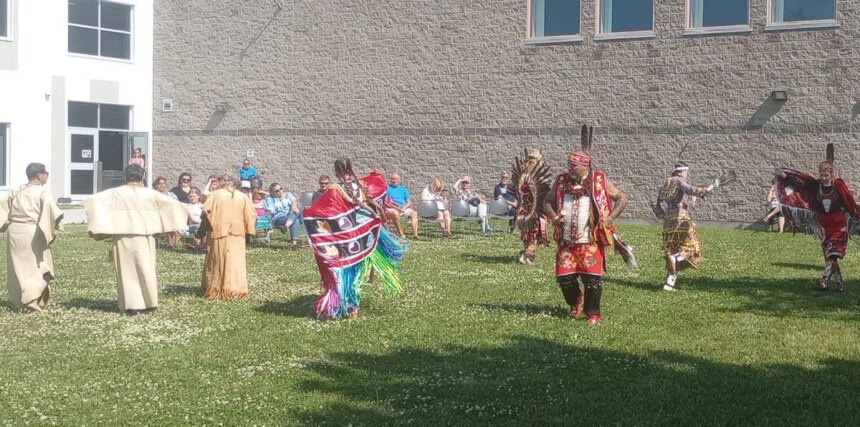The rhythmic beat of traditional drums echoed through Ma-te-way Park on Saturday as Renfrew residents gathered to celebrate National Indigenous Peoples Day. Under clear June skies, hundreds witnessed performances by the Morning Thunder Dance Troupe, whose vibrant regalia and precise footwork captivated attendees of all ages.
This celebration grows more meaningful each year, said Elder Margaret Whiteduck from the Algonquins of Pikwakanagan First Nation, who opened the ceremony with a traditional blessing. When I see children—Indigenous and non-Indigenous alike—learning these dances together, I see the path toward true reconciliation.
The annual event, organized by the Renfrew Indigenous Friendship Centre in partnership with the town council, has expanded significantly since its humble beginnings five years ago. What started as a small gathering now features food vendors, artisan displays, and educational workshops that stretched across the park’s eastern grounds.
Town councillor James Moore noted the celebration’s importance for the community. Our relationship with neighboring Indigenous communities isn’t just about acknowledgment—it’s about creating spaces where cultural exchange happens naturally, Moore said while helping volunteers distribute program guides. The attendance today shows how much our residents value these connections.
Morning Thunder’s lead dancer, Michael Commandant, guided spectators through the significance of each performance. The grass dance originated as a way to prepare ceremonial grounds, he explained before his troupe demonstrated the flowing movements that mimic wind sweeping through prairie grass. These aren’t just performances for entertainment—they’re living traditions that tell our stories.
For many local Indigenous youth, the celebration represented a chance to reconnect with cultural practices. Seventeen-year-old Amber Lavalley, who participated in her first public dance demonstration, described the experience as transformative. My grandmother taught me these steps when I was little, but I’ve never danced for a crowd before, she said. Seeing everyone’s reaction makes me proud of who I am.
The celebration coincided with the summer solstice, traditionally significant to many Indigenous cultures across Turtle Island. Local historian and teacher Robert Kennedy offered context through an educational booth where visitors learned about pre-colonial trade routes that once ran through the Ottawa Valley. This region has been a meeting place for thousands of years, Kennedy told curious attendees. The waterways we take for granted were ancient highways for commerce and cultural exchange.
According to Statistics Canada’s 2021 census, approximately 5% of Renfrew County residents identify as Indigenous, a number that has grown steadily over the past decade. This demographic shift has encouraged local institutions to develop more inclusive programming.
The Renfrew Public Library unveiled its expanded Indigenous literature collection during the celebration. Head librarian Sarah Thompson highlighted the importance of representation. We’ve added over 200 works by Indigenous authors this year, from children’s books to contemporary fiction and historical accounts, Thompson said. These stories need to be accessible to everyone in our community.
Food vendors offered traditional cuisine alongside educational components. Emma Benoît’s popular booth served bannock with various toppings while displaying information about the historical significance of Indigenous food systems. Food is an entry point to understanding culture, Benoît remarked as she handed a sample to a curious visitor. When people taste these flavors, they’re connecting to traditions that predate Canada itself.
The celebration wasn’t without acknowledgment of ongoing challenges. A quiet corner of the park housed the “Every Child Matters” display, where orange shirts hung in remembrance of children who never returned from residential schools. Many visitors left handwritten messages of support and commitment to reconciliation.
Chief Greg Sarazin of the Algonquins of Pikwakanagan First Nation addressed the gathering in the afternoon. Days like today matter because they create space for joy and celebration while acknowledging our continued resilience, Sarazin said. True reconciliation happens in communities like Renfrew when celebration leads to education, which leads to action.
Local business involvement reached a new high this year, with twenty-eight establishments contributing to the event. Diane Coulas, owner of Finnigan’s Road House, coordinated the food service volunteers. Five years ago, we struggled to find sponsors, Coulas recalled. Now businesses approach us asking how they can participate. That shift in community awareness means everything.
As the sun began its descent, participants joined in a community round dance, forming a circle that grew until it encompassed nearly the entire gathering. Hands linked across differences of age and background, moving in unison to the steady drumbeat.
For eight-year-old Noah Williams, who attended with his grandparents, the experience left a lasting impression. I liked the eagle dance the best, he said, demonstrating the wing movements he had learned. My teacher told us about Indigenous Peoples Day at school, but seeing it for real is way cooler.
The celebration concluded with a promise from organizers to expand next year’s event to two days, potentially including overnight camping and early morning ceremonies. As families departed with crafts, memories, and new understandings, the spirit of the gathering lingered—a community briefly transformed through cultural sharing and collective celebration.






